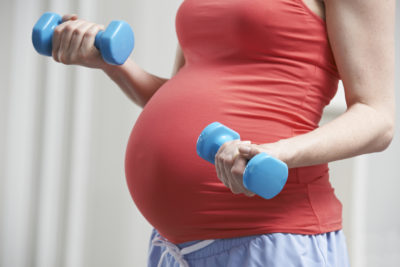 Many forms of exercise are acceptable throughout pregnancy. There are, however, some adjustments you may need to consider making to your routine. Some are just extensions of what you should already be doing. This is also known as common sense. Others are not so obvious.
Many forms of exercise are acceptable throughout pregnancy. There are, however, some adjustments you may need to consider making to your routine. Some are just extensions of what you should already be doing. This is also known as common sense. Others are not so obvious.
First, keep well hydrated
This one qualifies as common sense. Staying well hydrated is always important when exercising. It becomes even more important during pregnancy. Dehydration predisposes you to preterm uterine contractions (which hurt), and even preterm delivery of your infant (which is an entirely different ball game). So wherever you go to exercise, make sure you have ready access to clean drinking water. If you feel dizzy or lightheaded, by all means stop! Take a break and rehydrate before you start again.
Your exercise tolerance may be reduced
This one is also common sense. The human body is an incredible thing. One of the things it does really well is adapt to pregnancy. Just to do this, your cardiac output (the amount of blood your heart pumps per minute) increases by 30 – 50 percent.
Exercise places additional demands on your heart. While this is usually safe, you may notice that it takes less exercise to feel equally challenged. This is okay. Listen to your body and adjust your routine accordingly. With focus and discipline, you will be able to get back to your baseline after the baby is born.
Abdominal trauma & falling are bad
Abdominal trauma and falling are generally not good things. They are even more problematic during pregnancy. For example, your center of gravity changes a lot during pregnancy, and you may also lose sight of your feet. This combination may leave you feeling clumsy, and may make it easier to lose your balance and even fall. Pay attention to this.
Also avoid exercise that might result in trauma, abdominal or otherwise. Trauma can cause the placenta to separate prematurely. This conditioned is called placental abruption. Remember that the placenta is your baby’s lifeline, so this can have serious consequences such as increased risk of premature delivery and even fetal demise.
Here is a concrete way to think about this issue. Cycling, for example, is a great form of exercise during pregnancy. Cycling in heavy traffic where you are at risk for an accident or mountain biking on steep trails with large rocks and steep drop offs, however, are bad ideas. So even if this is how you normally cycle, consider training on a stationary bike for the duration of the pregnancy. (Hey, I live in Colorado, and there are a lot of extreme cyclists around here.)
Other things that seem like bad ideas in terms of risk of trauma and / or falling include downhill skiing, rock climbing, volleyball, and sky diving. Definitely no sky diving.
Being flat on your back is a problem
Your uterus and its passenger, also known as your baby, grow quickly and dramatically during your pregnancy. They are supposed to. Eventually, they fill your abdominal cavity. This causes the rest of the organs in your torso to be displaced. Some organs, such as your small intestine, are fairly mobile and can shift. Others are less mobile and end up a little compromised as a consequence.
One of these relatively fixed organs is your inferior vena cava, also known as your IVC. This is the single, very large vein that brings blood back to your heart from your lower extremities. It runs just anterior to your spine, which is made of bones.
As you know, bones are hard. During pregnancy, your uterus grows right in front of the IVC. When you lie flat on your back late in pregnancy, your IVC ends up being compressed between the weight of your uterus and your spine. This reduces the amount of blood that can return to your heart, which in turn reduces the amount of blood that can be pumped forward from your heart.
This can leave you feeling dizzy. You may even faint. This is why most experts recommend that you replace exercises usually done on your back with similar ones that can be done in a seated or standing position during the second half of your pregnancy.
My favorite form of exercise during pregnancy?
My favorite form of exercise during pregnancy is swimming. But my favorite form of exercise outside of pregnancy is also swimming.
Additional recommendations regarding exercise during pregnancy can be found in the Frequently Asked Questions handout published by the American Congress of Obstetrics and Gynecology (ACOG). It is available for free on the Patient Page of their website. They have all kinds of great patient information posted there.
To learn more about the normal cardiovascular changes that accompany pregnancy, read the previous post, Maternal Physiology 101.
While this information was derived from reliable medical sources, it is not intended as a substitute for your personal medical care. Readers are directed to consult with their personal health care team members when addressing their individual healthcare needs. This is particularly true when designing your exercise program.
